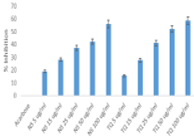Abstract
The richest biosource of drugs is from the medicinal plants, which are traditional medicine. The nutraceuticals, food supplements, Siddha, Ayurveda, pharmaceutical medications, synthetic drugs are from the plant sources. Despite a large number of studies with herbal plants which have given good correlation in the phytochemical, anti-diabetic and anti-inflammatory content, Nigella sativa- a spice plant of Ranunculacea family showed significant properties than their counterparts. The seeds of Nigella sativa and the essential oil were found to exhibit various pharmacological activities like anti analgesic, antiulcer, anti-inflammatory, antibacterial, antimicrobial, anticancer and anti-diabetic. In the clinical trials, since there are no toxic effects or severe side effects observed using an animal model, the study was carried out using Nigella sativa and Thymoquinone to find out the qualitative and quantitative phytochemical analysis, in-vitro - anti-diabetic activity, anti-inflammatory activity of Nigella sativa ethanolic extract and Thymoquinone effect on diabetes and Alzheimer's disease. The study aims to prove that to treat Alzheimer's disease, and Nigella sativa can be a therapeutic agent and the compound Thymoquinone a potential cholienesterase inhibitor for the treatment of Alzheimer’s disease.
Full text article
Authors

This work is licensed under a Creative Commons Attribution-NonCommercial-NoDerivatives 4.0 International License.

